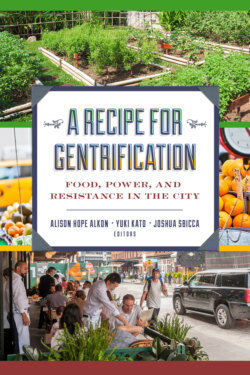Читать книгу A Recipe for Gentrification - Группа авторов - Страница 20
На сайте Литреса книга снята с продажи.
Durham, North Carolina
ОглавлениеLocated in central North Carolina, Durham County had an estimated population of 311,000 people in 2017, having grown by 15 percent since 2010 (US Census Bureau 2017). The city has gone through several periods of explosive growth and precipitous decline. Industrialization of the “bull city” was driven by the tobacco and textile industries in the nineteenth and early twentieth centuries, drawing workers from all over the South to jobs in factories and warehouses (Anderson 2011; Brown 2008). But Durham’s undiversified economy left it vulnerable, and starting in the 1970s, these industries lost out to changing tastes and global competition. Factories were abandoned, shops closed, and a significant percentage of the population dispersed to the suburbs or further afield.
Despite the loss of industrial employment, regional economic growth was strong in industries such as education, health care, and technology. A large office park, the Research Triangle Park, was established in the 1950s and is home to companies such as IBM, GlaxoSmithKline, and Lenovo. Duke and its vast medical facilities are also large drivers of jobs in the knowledge economy. Since the late 1990s, downtown redevelopment has been driven by a growth coalition composed of Duke University, Mayor Bill Bell (who retired in 2017 and was replaced by Council Member Steve Schewel) and the City Council, the County of Durham, banks, real estate developers, foundations, nonprofit organizations, and entrepreneurs. Redevelopment happened in fits and started during the 1990s and the first decade of the 2000s. Anchor projects like a new baseball stadium for the Durham Bulls minor league team and the adjacent mixed-use American Tobacco Campus were risky projects that brought together partners from the private and public sectors. While successful in attracting visitors, they had minimal spread effect through the city center. It wasn’t until the latter part of the 2000s that the economic wealth in the area started to translate into downtown development. A creative class of residents and entrepreneurs has since been attracted to the city by a palpable sense of pride in the city’s gritty character, renovated industrial architecture, and its “DIY” spirit. Along with inexpensive real estate, minimal business competition, a cooperative business environment, and help from the city and county, upscale businesses have blossomed. Historic industrial buildings that once housed thousands of middle-income jobs in tobacco are now loft condominiums, retail, and commercial space. Buildings that were either abandoned or occupied by retail focused on low-income patrons (for example, a discount furniture store and bail bonds) have evolved into the latest trendy restaurants.
The city is shedding its image among regional residents as dangerous and deserted. This characterization of the city was coded language that signified a large African American and low-income population in the central city. Durham is 47.9 percent white alone, 40.0 percent Black or African American alone, 5.1 percent Asian alone, and 13.9 percent Hispanic or Latinx in 2017 (US Census Bureau 2017). By contrast, the influx of new residents and the businesses that cater to them are mostly upper-income and white. Durham now sells itself as a hip city where restaurants and bars dominate the commercial streets, and affluent, predominantly white consumers feel welcome. As in other cities (see Hyra 2017; Zukin 1995, 2010), Durham’s post-industrial decline is a point of pride among many of the city’s residents and business owners. Urban grit is a marker of authenticity, in particular in contrast to the adjacent cities of Raleigh (seen as too corporate) and Chapel Hill (too college oriented). This ethos is exemplified in some of the slogans commonly seen on t-shirts and bumper stickers around town. For example, “Keep it dirty, Durham,” which encourages city residents to respect and celebrate the gritty character of the city. And, “Durham: it’s not for everyone,” which signals that the city is not intended to appeal to corporate, suburban, and/or unimaginative people. In an ironic twist, this slogan can be reinterpreted to mean that Durham is not a comfortable or affordable space for people who do not fit into some of these same categories.
The transformation of downtown Durham has created and exacerbated a number of social problems, such as housing affordability, economic inequality, and loss of cultural “soul.” Once known as the “capital of the Black middle class” (Frazier 1925:333), African American and Latinx communities have struggled to find a place in the new Durham. Displacement of existing businesses and the surge of new retail have changed the character of the city. Businesses that catered to lower-income people and people of color have mostly been priced out, replaced by stores and restaurants focusing exclusively on wealthy patrons. Additionally, median home prices in key neighborhoods have risen by 100 to 400 percent since 2005, causing gentrification and displacement of people of color and low-income populations (Norton 2015).
